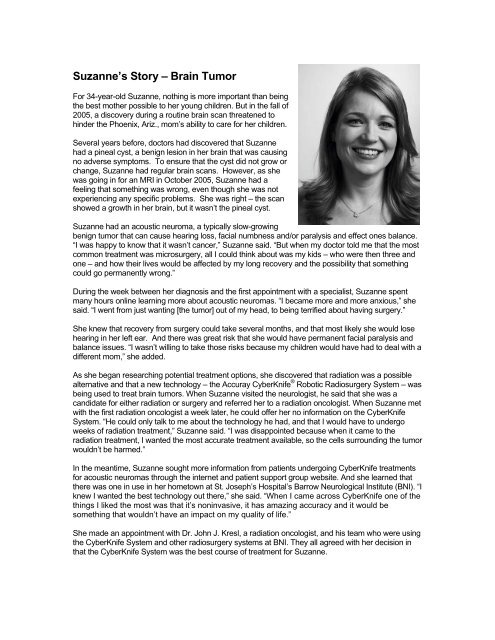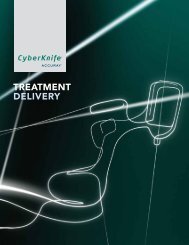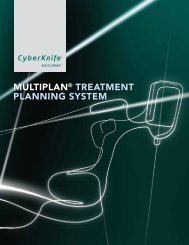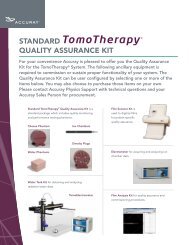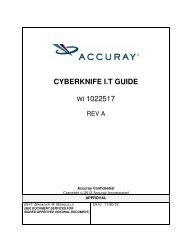Suzanne's Story â Brain Tumor - Accuray
Suzanne's Story â Brain Tumor - Accuray
Suzanne's Story â Brain Tumor - Accuray
You also want an ePaper? Increase the reach of your titles
YUMPU automatically turns print PDFs into web optimized ePapers that Google loves.
Suzanne’s <strong>Story</strong> – <strong>Brain</strong> <strong>Tumor</strong><br />
For 34-year-old Suzanne, nothing is more important than being<br />
the best mother possible to her young children. But in the fall of<br />
2005, a discovery during a routine brain scan threatened to<br />
hinder the Phoenix, Ariz., mom’s ability to care for her children.<br />
Several years before, doctors had discovered that Suzanne<br />
had a pineal cyst, a benign lesion in her brain that was causing<br />
no adverse symptoms. To ensure that the cyst did not grow or<br />
change, Suzanne had regular brain scans. However, as she<br />
was going in for an MRI in October 2005, Suzanne had a<br />
feeling that something was wrong, even though she was not<br />
experiencing any specific problems. She was right – the scan<br />
showed a growth in her brain, but it wasn’t the pineal cyst.<br />
Suzanne had an acoustic neuroma, a typically slow-growing<br />
benign tumor that can cause hearing loss, facial numbness and/or paralysis and effect ones balance.<br />
“I was happy to know that it wasn’t cancer,” Suzanne said. “But when my doctor told me that the most<br />
common treatment was microsurgery, all I could think about was my kids – who were then three and<br />
one – and how their lives would be affected by my long recovery and the possibility that something<br />
could go permanently wrong.”<br />
During the week between her diagnosis and the first appointment with a specialist, Suzanne spent<br />
many hours online learning more about acoustic neuromas. “I became more and more anxious,” she<br />
said. “I went from just wanting [the tumor] out of my head, to being terrified about having surgery.”<br />
She knew that recovery from surgery could take several months, and that most likely she would lose<br />
hearing in her left ear. And there was great risk that she would have permanent facial paralysis and<br />
balance issues. “I wasn’t willing to take those risks because my children would have had to deal with a<br />
different mom,” she added.<br />
As she began researching potential treatment options, she discovered that radiation was a possible<br />
alternative and that a new technology – the <strong>Accuray</strong> CyberKnife ® Robotic Radiosurgery System – was<br />
being used to treat brain tumors. When Suzanne visited the neurologist, he said that she was a<br />
candidate for either radiation or surgery and referred her to a radiation oncologist. When Suzanne met<br />
with the first radiation oncologist a week later, he could offer her no information on the CyberKnife<br />
System. “He could only talk to me about the technology he had, and that I would have to undergo<br />
weeks of radiation treatment,” Suzanne said. “I was disappointed because when it came to the<br />
radiation treatment, I wanted the most accurate treatment available, so the cells surrounding the tumor<br />
wouldn’t be harmed.”<br />
In the meantime, Suzanne sought more information from patients undergoing CyberKnife treatments<br />
for acoustic neuromas through the internet and patient support group website. And she learned that<br />
there was one in use in her hometown at St. Joseph’s Hospital’s Barrow Neurological Institute (BNI). “I<br />
knew I wanted the best technology out there,” she said. “When I came across CyberKnife one of the<br />
things I liked the most was that it’s noninvasive, it has amazing accuracy and it would be<br />
something that wouldn’t have an impact on my quality of life.”<br />
She made an appointment with Dr. John J. Kresl, a radiation oncologist, and his team who were using<br />
the CyberKnife System and other radiosurgery systems at BNI. They all agreed with her decision in<br />
that the CyberKnife System was the best course of treatment for Suzanne.
By the time she began her CyberKnife treatments a month later, Suzanne knew exactly what to<br />
expect. Suzanne was impressed that Dr. Kresl’s team showed her the CyberKnife System and the<br />
computers that run it. They explained in great detail how it worked – that it detects the slightest motion<br />
of the patient or tumor and would readjust immediately so it could continue targeting the tumor with<br />
extreme accuracy. And they made sure she knew what to expect during her treatment sessions.<br />
Prior to her treatment, Suzanne contacted the CyberKnife Patient Support Group, a community of<br />
patients who have been treated by the CyberKnife ® System. “I was able to ask them detailed<br />
questions, such as how they felt afterward, and even something as silly as what to wear to my<br />
treatment,” Suzanne said. “There was a woman from Australia undergoing the treatment at Stanford<br />
during that time, and through the support group, I was able to follow her progress every day and<br />
discuss with her how she was feeling. It really prepared me.”<br />
On a Friday in mid-December 2005, Suzanne had a CT scan and MRI to help doctors pinpoint the<br />
location of her tumor and plan her course of treatment. The next Monday she went in for the first<br />
treatment, which lasted one-and-a-half hours. She had two more treatments, lasting an hour each, on<br />
Tuesday and Wednesday.<br />
Though she was a little tired after each treatment, she was still able to go home each day and interact<br />
with her children as usual. “I didn’t feel a thing,” Suzanne recalled. “You almost wonder if it’s really<br />
doing anything because it’s completely painless.”<br />
But, in fact, the CyberKnife treatment was doing its job. In September 2006, her nine-month check-up<br />
showed signs that the tumor was dying. And, thankfully, Suzanne said, she has had none of the<br />
complications that are common when patients undergo microsurgery. She didn’t lose her hearing, her<br />
balance remains the same and she has no facial paralysis.<br />
“The entire CyberKnife journey was very easy,” Suzanne said. “My quality of life never changed, and<br />
for me, that was a big deal because I didn’t want my children’s lives to be different. There are others I<br />
know, who have had the same type of tumor and opted for microsurgery. But they have had<br />
completely different outcomes, and every day is hard for them. I feel almost guilty that the whole<br />
process has been so easy for me.”<br />
Suzanne added that she now knows she can not take anything for granted. “You just never know<br />
when your life may change. I had no reason to believe that anything was wrong with me,” she said.<br />
“Now I try to make the most out of my time with my family and my kids.”<br />
In December 2010 Suzanne went in for her five year, post-CyberKnife check-up and received a great<br />
report. “Everything is as it should be - all is well! So thankful and feel so blessed to have had<br />
CyberKnife to treat my tumor.”


